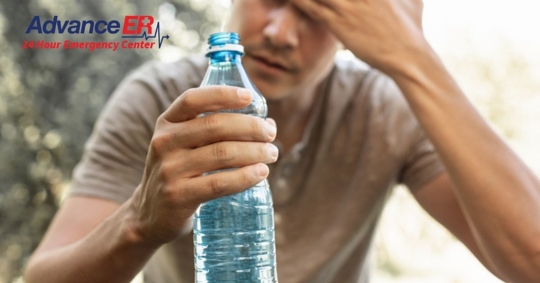Understanding Dehydration in Adults
Have you ever felt a sudden wave of fatigue or noticed your skin looking dull and dry? These could be your body's way of hinting at dehydration. While reaching for a glass of water might seem simple, the effects of dehydration dig much deeper than just feeling thirsty. The balance of fluids in your body plays a critical role in keeping everything—from your energy levels to your focus—in check.
The Science Behind Dehydration
Dehydration happens when your body loses more fluids than it takes in, throwing off the balance your cells need to function properly. Electrolytes like sodium, potassium, and chloride play a crucial role here; they help regulate everything from muscle movements to heart rhythms. When fluids are low, these electrolytes become imbalanced, resulting in symptoms that range from mild tiredness to serious health risks.
Your body is pretty smart about letting you know it needs more fluids. That familiar thirst is a signal, but ignoring it or not recognizing it in time can lead to problems. Factors like sweating, breathing, and even using the restroom contribute to daily fluid loss, and things like physical activity or high temperatures speed up that process. At the heart of it all is your body's need to stay in balance, something that's easier to maintain when you know what to watch for.
What Causes Dehydration in Adults?
Sometimes, dehydration sneaks up on you through daily habits. Skipping water, overdoing it on caffeine, or enjoying a few too many alcoholic drinks can all chip away at your hydration levels. Living in a hot or humid area makes it worse, as your body sweats more to cool off. For many, busy schedules mean hydration takes a backseat until noticeable symptoms kick in.
Dehydration isn’t just about lifestyle; it can also stem from illnesses or medications. Conditions like fever, diarrhea, and vomiting zap your body's fluid reserves, while certain medications, like diuretics, can increase the risk. Being mindful of these risks and making small adjustments, like drinking water regularly, can make a big difference.
Spotting the Signs and Symptoms
Dehydration speaks to you in subtle ways before things get serious. A dry mouth, fatigue, or darker urine are common early signs. On an emotional level, you might feel irritable or find it harder to concentrate. If ignored, more severe symptoms like dizziness, confusion, or even skin that doesn’t bounce back after being pinched can appear. These are signals to take action quickly.
For the average case of dehydration, sipping water and taking it easy can work wonders. But if symptoms like rapid heartbeat or sunken eyes show up, it’s a sign medical attention is needed. Listening to your body's warnings early can prevent complications and keep both your physical and emotional well-being intact.
Who’s at Higher Risk?
Some people are simply more vulnerable to dehydration.
Older Adults
With age, the body changes in ways that make staying hydrated more challenging. A declining sense of thirst is just one factor. Older adults also have less efficient kidneys, making it harder to conserve water. Mobility issues or memory problems can further complicate the effort to drink enough. Simple strategies, like setting reminders or eating more hydrating foods, can go a long way in reducing this risk. Family and caregivers can help reinforce steady hydration habits, offering much-needed support.
Individuals with Chronic Conditions
If you have a chronic illness like diabetes or kidney disease, the risk of dehydration often doubles. Frequent urination from high blood sugar or medications, like diuretics used for blood pressure, makes hydration a constant balancing act. Staying ahead of dehydration might mean working with healthcare providers to create a personalized hydration plan that fits your specific needs.
Active Lifestyles and Athletes
If you’re someone who works out or stays physically active, you’ve probably noticed how quickly you sweat during exercise. That sweat represents water and electrolytes your body can’t afford to lose without replenishment. Sipping water or electrolyte drinks before, during, and after physical activity can help you stay on top of your game and avoid unpleasant side effects like muscle cramps or heat exhaustion.
Keeping Hydration Simple
Prevention is key when it comes to dehydration. Most adults should aim to drink 2.7 to 3.7 liters of fluids daily, though certain factors like climate and activity might require more. Relying on your thirst can be a good start, but actively spreading your intake throughout the day is even better.
Hydration doesn’t always have to mean plain water. Herbal teas, smoothies, and even water-rich foods like cucumbers or oranges make great additions to your routine. Keep an eye on simple signs of proper hydration, like pale-yellow urine or regular energy levels, to ensure you’re on the right track.
Clearing Up Hydration Myths
There are plenty of misconceptions about hydration floating around. For instance, many believe caffeinated beverages don’t count toward fluid intake, but moderate coffee or tea can play a small role in keeping you hydrated. Similarly, water isn’t the only way to stay hydrated; fruits, soups, and broths contribute, too. The key is variety—finding what works for you and sticking with it.
We’re Here to Help
Dehydration can lead to serious health concerns when ignored, but acting early makes all the difference. If you’re in Dallas, TX, and find yourself or a loved one facing severe symptoms, don’t wait. At Advance ER, we’re here to help you get back to feeling your best.
Call (214) 494-8222 for immediate emergencies needing urgent care.

